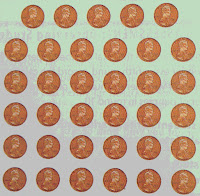Mr. Lee's Moon Rap video has also been a wonderful reference for us in class- check it out HERE.
Check out the Moon Giant website HERE to see tonight's moon phase to help you in filling out your Moon Calendar (homework assignment). You can also look back and look ahead (and see dates of the next Lunar and Solar Eclipses)!!
We have learned that the Moon has phases because it orbits Earth, which causes the portion we see illuminated to change.
The Moon takes about 27 days to orbit Earth, but the lunar phase cycle (from new Moon to new Moon) lasts about 29 days. The Moon spends the extra 2 days "catching up" because Earth travels about 45 million miles around the Sun during the time the Moon completes one orbit around Earth.
As we continue to study the Moon's phases we will complete a Moon Phase Gizmo, make edible "Oreo" Moon cycle models (yum) and compile little flip-booklets to help us learn what each phase is called. In doing this we will also deepen our understanding of several landmark moon phases. These are:
1) New Moon (the first (1)and last (29) day in the cycle
At the New Moon phase the Moon is so close to the Sun in the sky that none of the side facing Earth is illuminated. In other words, the Moon is between Earth and Sun.
2) First Quarter Moon (around Day 8 in the cycle)
ONE QUARTER (the RIGHT quarter that we see) is lit....here, the moon is highest in the sky at sunset, then sets about six hours later.
3) Full Moon (around Day 15- the middle of the 29 day cycle)
On this day, the Moon is behind Earth in space with respect to the Sun. As the Sun sets, the Moon rises with the side that faces Earth fully exposed to sunlight. We are able to see the entire illuminated half of the moon!
4) Last (Third) Quarter Moon (around Day 21) ONE QUARTER (the LEFT quarter that we see) is lit.... (opposite of the First Quarter Moon).
---------------------------------------------------------------------
Waxing means "increasing" in illumination
Waning means "shrinking" in illumination
Crescent means "with concave and convex edges" (where less than half of the moon is illuminated from our perspective... think of a curved pastry or dinner roll)
Gibbous means "humpback" (where more than half of the moon is illuminated from our perspective)
Here are several examples:

Waxing Crescent
(growing/increasing in illumination and less than half illuminated from our perspective on Earth)
(growing/increasing in illumination and less than half illuminated from our perspective on Earth)
Waxing Gibbous
(growing/increasing in illumination and more than half illuminated from our perspective on Earth)
(growing/increasing in illumination and more than half illuminated from our perspective on Earth)
Waning Gibbous (shrinking in illumination and more than half illuminated from our perspective on Earth)
Waning Crescent
(shrinking in illumination and less than half illuminated from our perspective on Earth)
(shrinking in illumination and less than half illuminated from our perspective on Earth)
STUDY TIP: Notice that with Waxing phases the illumination is always on the RIGHT and with Waning phases the illumination is always on the LEFT.
-------------------------------------------------------------------------------------------

You can click HERE to see a simple, quick time-lapsed video of the Moon Phase Cycle that really helps to show how all of these phases relate and change throughout the cycle.
Happy Sciencing!!

























